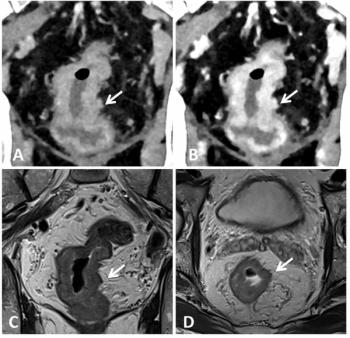
MRI Detects Blood/Brain Barrier Leaks in Early Alzheimer’s
MRI may help detect Alzheimer’s before directly visible cerebrovascular abnormalities are present.
MRI identified leaks in the blood/brain barrier (BBB) among people with early Alzheimer’s disease, according to a study published in
Researchers from the Netherlands performed a small pilot study to determine if BBB leaks of blood-circulating substances existed in patients who have early Alzheimer’s disease and if so, to what extent.
Sixteen patients with early Alzheimer’s disease and 17 controls participated in the the study. They all underwent dynamic contrast material-enhanced MRI, after which it was determined that the BBB leakage rate was significantly higher in patients compared with that in control subjects in the total gray matter and cortex. Patients had a significantly higher volume fraction of the leaking brain tissue in the gray matter, normal-appearing white matter, deep gray matter, and cortex.
“Blood-brain barrier leakage means that the brain has lost its protective means, the stability of brain cells is disrupted and the environment in which nerve cells interact becomes ill-conditioned,” study author Walter H. Backes, PhD, from the Maastricht University Medical Center, said in a release. “These mechanisms could eventually lead to dysfunction in the brain.”
The results also showed that the Mini-Mental State Examination scores decreased significantly with increasing leakage in the deep gray matter and cortex.[[{"type":"media","view_mode":"media_crop","fid":"49141","attributes":{"alt":"","class":"media-image media-image-right","id":"media_crop_5302911426625","media_crop_h":"0","media_crop_image_style":"-1","media_crop_instance":"5918","media_crop_rotate":"0","media_crop_scale_h":"0","media_crop_scale_w":"0","media_crop_w":"0","media_crop_x":"0","media_crop_y":"0","style":"height: 144px; width: 249px; border-width: 0px; border-style: solid; margin: 1px; float: right;","title":"A, Axial fluid-attenuated inversion recovery image in a 68-year-old man with, B, corresponding BBB leakage rate (Ki) maps superimposed. Leakage rate values appear diffusely distributed on both images, with some periventricular hot spots. Leakage manifests in normal-appearing WM, WM hyperintensities, and GM. Voxels with low signal-to-noise ratio in MR imaging signal intensity were removed, and leakage rate map was masked to cerebrum. Image courtesy of Radiology. ©RSNA, 2016","typeof":"foaf:Image"}}]]
The researchers concluded that a compromised BBB may be part of a cascade of pathologic events that eventually lead to cognitive decline and dementia, and that contrast MRI may help detect early microvascular changes in Alzheimer’s disease before there are any directly visible cerebrovascular abnormalities.
“For Alzheimer’s research, this means that a novel tool has become available to study the contribution of blood-brain barrier impairment in the brain to disease onset and progression in early stages or pre-stages of dementia,” Backes concluded in the release.
Newsletter
Stay at the forefront of radiology with the Diagnostic Imaging newsletter, delivering the latest news, clinical insights, and imaging advancements for today’s radiologists.



























